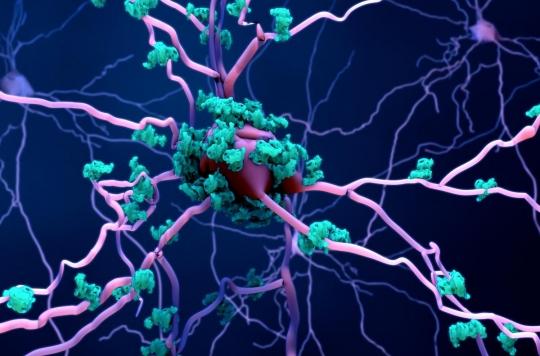The TET1 molecule, through its action on glial cells, participates in the production of myelin. The latter is essential for the maintenance of cognitive and motor functions.

- The TET1 molecule modifies the DNA of glial cells in the brain, which influences the production of myelin, responsible for maintaining cognitive and motor functions.
- Influencing the production of myelin, via a sufficient quantity of TET1, could make it possible to restore the cognitive and motor functions of an individual.
His nickname is “TET1”, for “ten-eleven-translocation 1”. According to a team of researchers from the Advanced Science Research Center at The Graduate Center (CUNY ASRC), this molecule could restore cognitive and motor functions in humans. Their work has just been published in the journal NatureCommunications.
Myelin is produced by glial cells in the brain…
To reach this conclusion, the scientists conducted several experiments on mice. Their goal was to identify a molecule that influences the production of myelin, a membrane that surrounds neurons. This insulates and protects the nerve fibers of the brain and spinal cord, it is therefore essential to the central and peripheral nervous system, in particular for the conduction of nervous messages. Myelin is produced, in part, by glial cells. These are particularly sensitive to different signals, such as physical activity, mental stimulation or injuries. So when they face one of these situations, they produce myelin, which protects the nervous system. But, with aging, glial cells produce less myelin.
…whose DNA is modified by the TET1 molecule
Thanks to their work, scientists have just understood why the production of myelin decreases with age. “We find that levels of TET1 gradually decline in older mice, and due to this decline, DNA can no longer be properly modified to form new functional myelin.” explains Sarah Moyon, lead author of the study. But how does TET1 work? This molecule is able to modify the DNA of glial cells in the brain so that they can produce myelin in response to an injury, for example. With sufficient amounts of TET1, glial cells could therefore maintain the same level of myelin production even when the individual is old.
A sufficient amount of TET1 would help repair the brain
The researchers now want to continue their research to determine exactly how much TET1 would help repair the brain. In other words, to restore the production of myelin and the proper conduction of nerve messages. In the long term, it might be possible to influence the production of this molecule, through treatment for example, in order to limit the deterioration of cognitive and motor functions in the elderly and in patients with neurodegenerative diseases. Indeed, one of the causes of Alzheimer’s disease or multiple sclerosis is the decrease in the production of myelin.
Hope for people with neurodegenerative diseases
According to’National Institute of Health and Medical Research (Inserm), 900,000 people suffer from Alzheimer’s disease in France. Multiple sclerosis, an autoimmune disease that affects the central nervous system, concerns 110,000 individuals in France and is the leading cause of severe non-traumatic disability in young adults.
.















